Accepted Scientific Name: Blossfeldia liliputana Werderm.
Kakteenkunde 1937: 162, figs. [et in: Werderm. & Krainz Neue u. seltene Sukkulent. 10 1946, descr. ampl.]

Parodia liliputana (Blossfeldia liliputana) Photo by: Valentino Vallicelli
Origin and Habitat: Blossfeldia liliputanaSN|5701]]SN|5701]] is established over a wide geographical area ranging from Southern Bolivia (Potosí Department) to north-western Argentina (Jujuy, Salta, la Rioja, Mendoza, San Juan and Catamarca Provinces).
Altitude: 1100 to 2500(-3600?) metres above sea level. The species grows in patches and is not frequent, but is locally very abundant.
Habitat: The species grows in monte, chaco and prepuna. Plants are found growing in sunny dry places between boulders on rocky slopes and often between cracks near the rivers in the sides of vertical stone cliffs with a little fine soil mainly on shale like rock formations often close to waterfalls where they have a almost continuous water flow running over them, but can withstand severe drying out and (in habitat) they can survive to nearly complete desiccation, recovering when fog, mist or rain returns to their natural environment. Their colour and shape is hardly distinguishable from a stone and are not significantly threatened by human influences. However the species is sought after by collectors, whenever a new population is discovered it is rapidly depleted. Trade is mainly national but international trade exists too.
Synonyms:
See all synonyms of Blossfeldia liliputana
back
Accepted name in llifle Database:Blossfeldia liliputana Werderm.Kakteenkunde 1937: 162, figs. [et in: Werderm. & Krainz Neue u. seltene Sukkulent. 10 1946, descr. ampl.]Synonymy: 24
back
Common Names include:
CHINESE (中文): 松露玉
Description: Blossfeldia liliputana, is a solitary or clumping miniature cactus, with no rib and no spines. The smallest of all cacti and one of the most priced by impassioned, but rarely seen on its own roots in cultivation for any length of time. Although several species of Blossfeldia with minimal differences have been described (as many as six), most botanist agree on the fact that all the ones described until now should all be included in the Blossfeldia liliputanaSN|5701]]SN|5701]].
Habit: It is an highly specialized specialized species with a unique growth habit. Its minuscule stems during the dry season, lose almost all of their water and shrink, becoming almost completely dry and flattened on the rocks where it lives.
Stem: Flattened disc-shaped, gray-green, usually up to 1.2 cm in diameter (rarely exceed the 2, but in cultivation grafted plants may attain a bigger size.
Ribs: Bodies have no ribs or tubercles.
Areoles: Spiralling bearing tufts of wool and no spines.
Root: Tuberous.
Flower: Diurnal, white or pinkish (yellow) diurnal, 6-15 mm long and 5-7 mm diameter and self fertile.
Flowering season: The main flowering season is from late spring to early summer.
Seed: The seeds are minuscule (like dust), globose (less than 0.5 mm) with a large swelling of the upper funiculus thst is equal in size to the seed; this corky structure (strophiole ot aril) also occurs in other species of tribe Notocacteae that are believed to he closely related to Blossfeldia (I.e. Frailea). This species also has prominent trichomes (minuscule hairs) on seed coat, one per cell. The seeds represent a particular adaptation to ant dispersal. The ants which, having been lured by the aril, grasp the seeds on their hairy surface and carry them to their nests.
Chromosome number: Blossfeldia appears to be exaploid.
Remarks: The spelling is often cited as "Blossfeldia liliputanaSN|5701]]SN|5701]]", but under the provisions of the International Code of Botanical Nomenclature this is an orthographic error to be corrected to "Blossfeldia liliputiana".
Notes: Bloosfeldia is a poikilohydric and almost astomate succulent: This remarkable miniature is the most enigmatic of all cacti, confounding us with its physiological, anatomical, morphological, ecological and evolutionary peculiarities. They are apparently the only cacti that are capable of completely drying out and then rehydrating their cells when watered (called "poikilohydric" or popularly "resurrection plants"). It has been found to lose up to 80% of its moisture in one year and then survive drought for an additional year, making it very similar to mosses and lichens in being adapted to withstand near complete loss of moisture! It could be that what looks like a few dried out and dead seedlings could be revived by a thorough soak. Except for certain parasites and aquatics, this species possesses the lowest density of stomata of any terrestrial flowering plant.
Bibliography: Major references and further lectures
1) Edward Anderson “The Cactus family” Timber Press, Incorporated, 2001
3) James Cullen, Sabina G. Knees, H. Suzanne Cubey "The European Garden Flora Flowering Plants: A Manual for the Identification of Plants Cultivated in Europe, Both Out-of-Doors and Under Glass" Cambridge University Press, 11/Aug/2011
4) David R Hunt; Nigel P Taylor; Graham Charles; International Cactaceae Systematics Group. "The New Cactus Lexicon" dh books, 2006
5) N. L. Britton, J. N. Rose: “The Cactaceae. Descriptions and Illustrations of Plants of the Cactus Family.” Volume III, The Carnegie Institution of Washington, Washington 1922
6) Karen van Rheede van Oudtshoorn, Margaretha W. van Rooyen “Dispersal Biology of Desert Plants” Springer, 1999
7) Barthlott W, Porembski St “Ecology and morphology of Blossfeldia liliputana (Cactaceae): a poikilohydric and almost astomate succulent.” Bot Acta 109:161-166 1996
8) Arthur C. Gibson “The Cactus Primer” Harvard University Press, 1990
9) Sara Oldfield “Cactus and Succulent Plants: Status Survey and Conservation Action Plan” IUCN, 01/Jan/1997
10) John Pilbeam “Cacti for the Connoisseur: A Guide for Growers & Collectors” Timber Press, 01/Jul/1987
11) Buxbaum F., “Gattung Blossfeldia”, in Krainz H., Die Kakteen, 1.11.1964
12) Fechser H., “Blossfeldia liliputana - The Tiniets Cactus”, Cact. Succ. J. (US), 32 : 123-125, 1960
13) John V., “Strombocactus, Blossfeldia a Aztekium”, Kaktusy, 23 : 38-41, 1987
14) Kilian G., “Beitrag zur Blossfeldia-Kultur”, Kakt. und and. Succ., 13 : 82-83, 1962
15) Köhler U., “Beobachtungen an Blossfeldien”, Kakt. und and. Succ., 17 : 11-14, 1966;
16) “Blossfeldia heute”, Kakt. und and. Sukk., 32 : 132133, 1981
17) Říha J., “Blossfeldia liliputana” Werdermann, Kaktusy, 22 : 105-107, 1986
18) Ильяшенко О. В., Белоус Ю. Н., Сушак Ю. П. "Уникальная энциклопедия. Кактусы.", 2003
19) Innes C, Wall B. "Cacti Succulents and Bromaliads." Cassell & The Royal Horticultural Society. 1995
20) Haage W. “Kakteen von A bis Z.” Leipzig. l979
21) Leuenberger, B. E. & U. Eggli. “Notes on the genus Blossfeldia (Cactaceae) in Argentina.” Haseltonia 6:2-13 1998.
22) Kiesling, R. 2013. Blossfeldia liliputana. The IUCN Red List of Threatened Species 2013: e.T152364A628571. . Downloaded on 28 February 2016
23) Kiesling, R. and Ferrari, O.E. “100 Cactus Argentinos.” Albatros, Buenos Aires. 2009
24) Gómez-Sánchez, A. “Enciclopedia Ilustrada de los Cactus y otras Suculentas: Descripción de las especies, hábitat y cuidados de cultivo.” Mundi-Prensa, Madrid. 2006
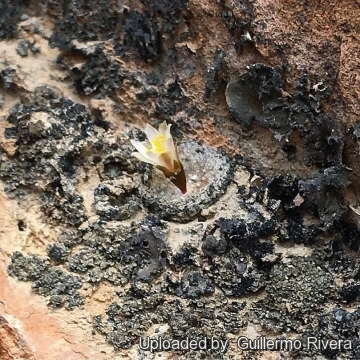 Blossfeldia liliputana, Bolivia. (Blossfeldia liliputana) Photo by: Guillermo Rivera
Blossfeldia liliputana, Bolivia. (Blossfeldia liliputana) Photo by: Guillermo Rivera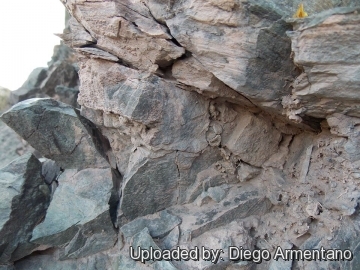 Perhaps the smallest of all cacti blossfeldias grow nestled in cracks of rocky walls, and are difficult to see, as you can see. (Blossfeldia liliputana) Photo by: Diego Armentano
Perhaps the smallest of all cacti blossfeldias grow nestled in cracks of rocky walls, and are difficult to see, as you can see. (Blossfeldia liliputana) Photo by: Diego Armentano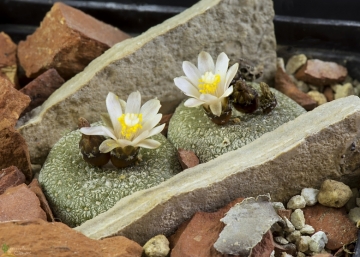 Parodia liliputana (Blossfeldia liliputana) Photo by: Peiffer Clement
Parodia liliputana (Blossfeldia liliputana) Photo by: Peiffer Clement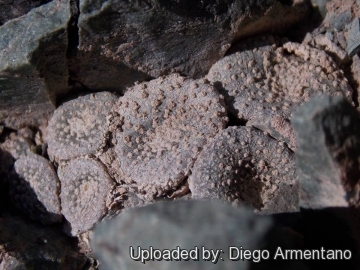 In habitat, northern Argentina. 2324 metres above sea level. (Blossfeldia liliputana) Photo by: Diego Armentano
In habitat, northern Argentina. 2324 metres above sea level. (Blossfeldia liliputana) Photo by: Diego Armentano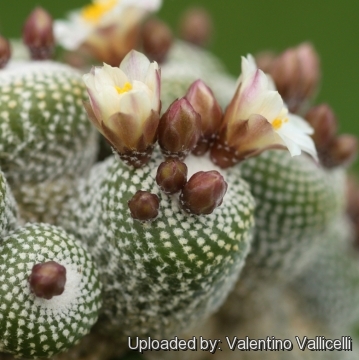 Parodia liliputana (Blossfeldia liliputana) Photo by: Valentino Vallicelli
Parodia liliputana (Blossfeldia liliputana) Photo by: Valentino Vallicelli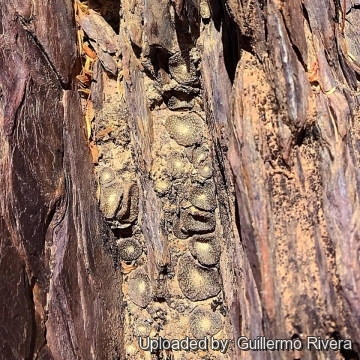 Blossfeldia liliputana, Bolivia. (Blossfeldia liliputana) Photo by: Guillermo Rivera
Blossfeldia liliputana, Bolivia. (Blossfeldia liliputana) Photo by: Guillermo Rivera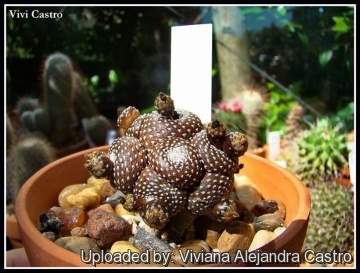 Parodia liliputana (Blossfeldia liliputana) Photo by: Viviana Alejandra Castro
Parodia liliputana (Blossfeldia liliputana) Photo by: Viviana Alejandra Castro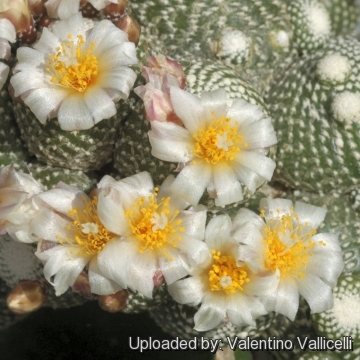 Parodia liliputana (Blossfeldia liliputana) Photo by: Valentino Vallicelli
Parodia liliputana (Blossfeldia liliputana) Photo by: Valentino VallicelliCultivation and Propagation: The specialized environment of Blossfeldia liliputanaSN|5701]]SN|5701]] (mountain rock cracks), and the extremely dry environment makes them very sensitive to root loss. Because of their slow growth rate, Blossfeldias are often grafted, which causes them to grow very fast and offset heavily but lose their characteristic disc-like shape, becoming quite globular and bloated. In this case the minimum temperatures acceptable should take in account the requirements for the rootstock. Any way this miniature is grown, it is a true wonder of the plant kingdom.
Growth rate: Extremely slow growing unless grafted.
Soil: Grow it in a particularly draining substratum, as it is very sensitive to rottenness when in presence of humidity and low temperatures and let the soil dry out between waterings.
Repotting: Repot in the spring, when their roots become cramped. Generally, they should be repotted every 2-4 year in order to provide fresh soil. After repotting, do not water for a week or more. Use pot with good drainage. However, repotting doesn't necessarily mean they'll need larger containers.
Fertilization: It grows faster with a low nitrogen content fertilizer in spring and summer.
Watering: Water during the aestival growth cycle from March till October, the thin, fibrous roots suffer if there is humidity, therefore the plant should be watered only when the surrounding terrain is dry. But needs to be avoided wetting the bodies of these plants while they are in sunlight. A wet cactus in the sun light can cause sun burning which can lead to scares or even fungal infections and death. Keep dry as soon as the temperature starts dropping in October and keep it perfectly dry in winter at temperatures from 5 to 15 degrees centigrade. Preferable not to water on overcast days, humid days or cold winter days.
Hardiness: They need to be kept in a cool place during winter rest and can tolerate sporadic frost if kept on the dry side prior to, and during, cold weather with little danger of being killed (Frost Tolerance: At least -10°C). However in cultivation it is better not to expose it to temperatures lower than 5° C, even if in an aerated and protected location. It tends to rot in winter during the resting phase, if kept wet. In the rest period no high atmospheric humidity!!
Sun Exposure: Some shade with ample airflow is preferred for best appearance.
Pests & diseases: It may be attractive to a variety of insects, but plants in good condition should be nearly pest-free, particularly if they are grown in a mineral potting-mix, with good exposure and ventilation. Nonetheless, there are several pests to watch for:
- Red spiders: Red spiders may be effectively rubbed up by watering the infested plants from above.
- Mealy bugs: Mealy bugs occasionally develop aerial into the new growth among the wool with disfiguring results, but the worst types develop underground on the roots and are invisible except by their effects.
- Scales: Scales are rarely a problem.
- Rot: Rot is only a minor problem with cacti if the plants are watered and “aired” correctly. If they are not, fungicides won't help all that much. To prevent rottenness it is also advisable to surround its root neck by very rough sand or grit, this help a fast water drainage.
Propagation: Almost exclusively by seed and graft. The minuscule seeds should be sown on the surface of a very finely sifted soil mix. These plants are very slow growing and is very difficult to keep them alive on their own roots for the first 4-6 months and should be watered by carefully misting with a hand held spray bottle until they are large enough to be watered normally (2 to 5 years!). But the bagging is the preferred sowing method for this plant, of course, maximum sterilization is important in that method as the bag remains sealed for up to two years. We have even heard of people successfully growing this plant on a porous rock. Many growers graft tiny 2-3 month seedlings and they grow on very successfully that way.
Your Photos

by Cactus Art
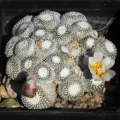
by Valentino Vallicelli
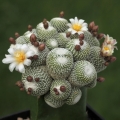
by Valentino Vallicelli
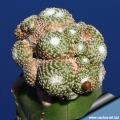
by Cactus Art
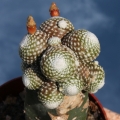
by Valentino Vallicelli























